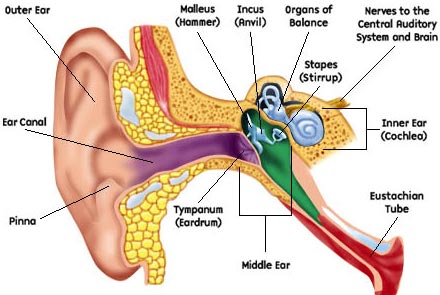Understanding how the ear works is relaitvely simple. Sound travels through the air around us as sound energy, also called sound waves. Our ears serve to convert those sound waves into a form that can be interpreted by the brain, which receives only electrical impulses. The three parts of the ear – the outer ear, middle ear, and inner ear – each play a critical role in this process.
Outer Ear
The outer ear consists of the pinna, which is the external skin and cartilage on both sides of our heads that we think of when we hear the word “ear,” as well as the external auditory canal. The shape of the pinna is ideal to collect the sound waves, direct them down the ear canal, and vibrate the tympanic membrane, or eardrum.
Middle Ear
The eardrum separates the outer ear from the middle ear. In the middle ear, the eardrum’s vibrations move the Malleus (hammer), the Incus (anvil) and the Stapes (stirrup) bones of the middle ear, collectively known as the ossicles. With motion of the ossicles, the sound waves that first entered the ear canal have been converted to mechanical energy, and this energy is conducted toward the inner ear.
Inner Ear
Movement of the ossicles causes vibrations in the fluid of the cochlea, the hearing portion of the inner ear. As the cochlear fluid vibrates, it moves thousands of tiny hair-like nerve cells that line the cochlear walls, which serves to convert the mechanical energy of the ossicles into the requisite electrical nerve impulses. These impulses travel from the cochlea up the auditory nerve, where they are received and given meaning and relevance by the brain.
The cone-shaped bone that forms the part of the skull immediately below and behind each ear is called the mastoid process. The internal ear structures and hearing processes are protected deep within this bone.
